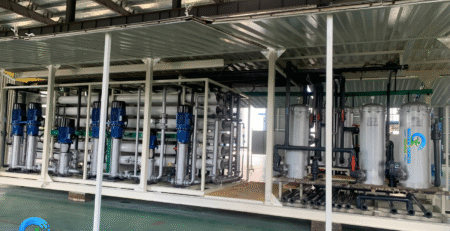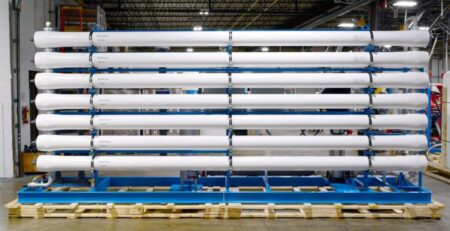Different Process for Textile Effluent Treatment Plants
Using a Textile Effluent Treatment Plant (TETP) for treatment of wastewater from the textile industry is an option that can be explored, depending on the specific requirements of the facility. Using an Effluent Treatment Plant for Textile Industry, can also help to address any water quality issues that the facility may face. A TETP is a unique treatment system that combines physio-chemical treatment with chemical coagulation to remove contaminants and impurities from the wastewater.
What is is the Different Treatment Process in Textile Effluent Plant?
Various types of treatment processes are used for textile effluent treatment. These processes include physical and chemical methods, which are based on the use of coagulants, flocculants, and adsorbents. These processes are used to degrade both organic and inorganic pollutants.
Textile effluents are usually high in color, suspended solids, and biochemical oxygen demand (BOD). These effluents contain organic compounds, metals, salts, and ammonia-nitrogen.
- In the past, many researchers have applied different processes to treat textile wastewater. One of the most effective processes for textile wastewater treatment is adsorption. This process uses adsorbent materials, which have a large surface area. The adsorbent attracts molecules and separates them from dissolved chemical compounds. Adsorption is a simple and effective process.
- Another effective process is electro coagulation. This process removes colour effectively. However, it requires energy and produces sludge, which is hazardous. The efficiency of electro coagulation is dependent on the pH value and the electrical current used.
- Using photochemical oxidation processes can help degrade the recalcitrant organic material in textile wastewater. This is a more cost-effective process. During this process, the recalcitrant compound is oxidized by the production of highly reactive radicals.
- Another process, ultrasonic catalysis, uses ultrasonic energy to enhance the interaction between radical and dye molecules. This process can be combined with photolytic energy or acoustic energy. This process produces highly reactive radicals and can be used for increasing the efficiency of textile effluent treatment.
- Another process, ozonation, could be used for the degradation of recalcitrant compounds. This process also uses UV radiation. This process could be combined with membrane treatments or anaerobic biofilm reactor.
- Other processes include coagulation-flocculation, which is used to destabilize colloidal material. This process is also used in the treatment of industrial wastewater.
What is Chemical Coagulation in Wastewater Treatment Plants for Textile Industry?
Textile Effluent Treatment Plant combines chemical coagulation with electrochemical oxidation in order to remove unwanted chemicals and contaminants from textile wastewater. This is an economically and technically efficient system that complies with statutory pollution control requirements.
Chemical coagulation is a process in which particles are neutralized to form larger and more stable flocs. The chemical coagulation process can vary depending on the pH of the solution. This process has been reported to reduce COD and TSS in the effluent.
 Different Types of Coagulant Used in Textile Wastewater Treatment?
Different Types of Coagulant Used in Textile Wastewater Treatment?
There are several types of coagulants used in industrial wastewaters. These include aluminium salts, iron salts and ferric salts. Depending on the amount of coagulant used, the density of the flocs can be increased.
The use of an aluminium-based coagulant can increase the quality of the effluent. Aside from reducing COD, the coagulant can also improve the clarity of the water.
The coagulant must be added to the proper dosage. The dosage depends on the amount of coagulant needed to destabilize the effluent. It is important to know how much coagulant needs to be added to achieve the maximum reduction in COD and TSS.
The pH of the solution must be neutral. A coagulant is added to the solution to neutralize the electrical charge surrounding the particles. The coagulant will coagulate the particles by generating curdling.
The pH requirement for the textile effluent is aligned with that for the coagulant. The coagulant will also remove turbidity in the raw water.
The amount of coagulant is optimized with the response surface methodology. This methodology is a statistical technique that optimizes pH and the coagulant dose. The treatment system was designed by performing optimization experiments on real textile wastewater.
The Bottom Line
The methods for attaining environmental protection that are most frequently acknowledged involve effluent treatment facilities. Depending on the pollutant load, a variety of procedures, including physical, chemical, and biological treatment, are used to treat the wastewater.
Wastewater treatment systems are crucial in the textile and apparel industries because they produce effluents with highly variable compositions. The greatest alternative for a secure setting free of textile waste is an effluent treatment plant, which also saves money and the planet while providing good treatment outcomes.
Textile Effluent Treatment Plants Frequently Asked Questions
1) What are the main sources of pollutants in textile effluent?
The textile effluent is extremely poisonous due to the presence of many dyes including sulphur, azoic, indigoids, nitrates, acidic acid, soap, enzymes, complex compounds, heavy metals, and a few auxiliary chemicals.
2) How is Color removed from the effluent of textile industry?
Chemical oxidation eliminates the dye from effluent that contains dye by oxidizing the dye and causing the dye molecule’s aromatic ring to cleave. In the treatment of wastewater, oxidants are used.
3) How many steps are there in effluent treatment?
The primary, secondary, and tertiary water treatment stages are the three main phases of the wastewater treatment process. More sophisticated treatment, or quaternary water treatment, is necessary in particular applications.
4) What are the two types of effluent release?
Technology-based effluent limits and effluent limits based on water quality are the two main categories of effluent limits.
5) What is the process of effluent treatment plant?
The wastewater is gathered in a combined effluent tank already in place, from which it is pumped to the aeration tank, which also functions as an equalization tank. Effluent is homogenized by the floating aerator before being pumped to the neutralization tank.
6) How many types of effluent treatment plants are there?
The following are some of the most significant categories of wastewater treatment processes: 1. Wastewater Treatment Facilities (ETP) Sewage Treatment Facilities (STP) 3. Plants for the Common and Combined Treatment of Effluent (CETP).
7) Why is ETP important in textile industry?
Gaining recognition from overseas purchasers and subsequently growing the exports of clothing to the foreign market is one of the main advantages of successfully managing the ETP.











